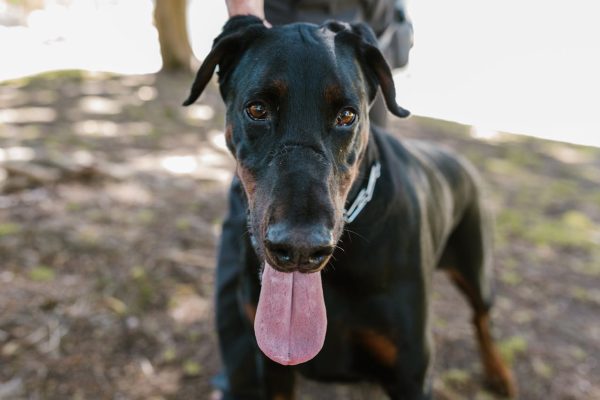In this article
View 2 More +You’ve likely seen 101 Dalmatians, so you probably know a bit about the adorable and spotted Dalmatian breed. However, you might have heard that this breed is aggressive, which could cause concerns if you’re considering adopting one of these dogs. But is that true? Are Dalmatians aggressive? The answer can’t be yes or no, since the way a Dalmatian may respond to certain situations depends on genetic and environmental factors. Your pet’s personality and the training you provide will have a huge impact on the way they behave.
On the whole, these pups are affectionate and can make fantastic pets for the right people, but they are also extremely high-energy, a bit stubborn, and protective in nature. That protectiveness (and their tendency to be a little wary of strangers) means there are situations where the Dalmatian might react rather intensely. Any dog has the potential to develop aggressive behaviors if they are anxious, scared, or poorly socialized, but this does not mean that they are aggressive in nature.
This breed is usually quite playful and adaptable. Like any dog breed, they may show aggressive behaviors in certain circumstances, but generally speaking, this breed is not known for having aggressive tendencies toward people or other dogs.

The History of the Dalmatian
To better understand the Dalmatian, you should know a bit more about the breed’s history. The origin of this breed is a bit mysterious. It’s thought that Dalmatians came to Europe by way of the Romani people, who came there via India. Though the name of this dog breed comes from a narrow belt near the Adriatic Sea, no one is exactly sure where the breed originated.
What we do know for sure is that this is an ancient breed. Paintings in Egyptian tombs have been found that show spotted canines running beside chariots. Those spotted pups might not be the Dalmatian as we know it today, but they’re probably ancestors of the breed.

The Dalmatian may be most well-known as a firehouse mascot, but before that, these dogs played several different roles throughout history. They were originally bred to guard people riding in stagecoaches and similar vehicles, but these pups also acted as hunting dogs, herding dogs, and even military guards who guarded borders. All of this adds up to an active, intelligent, quick, protective, and loyal pup.
Along with being protective, this breed has a tendency to be a little wary around strangers. This makes them fantastic watchdogs, but if not properly trained, this combination of protectiveness and wariness could result in reactivity and aggressive tendencies.

Why Might a Dalmatian Be Aggressive?
Other than their natural wariness and protectiveness, there are a few other reasons Dalmatians might become aggressive.
1. Poor Breeding
When the movie 101 Dalmatians came out, it was a hit, and as a result, more people became interested in the Dalmatian breed. But since the way the breed was portrayed in the film wasn’t entirely accurate (for example, this breed is incredibly active!), this awareness and newfound fondness for Dalmatians ended up being harmful rather than helpful for the breed.
Many families ended up adopting one of these pups after seeing the film and having their kids beg for a Dalmatian, but they didn’t entirely know what they were getting themselves into.
After adopting Dalmatians, many people realized they weren’t able to handle caring for this breed, and as a result, many dogs were turned into shelters. This phenomenon was so prevalent it earned the moniker of 101 Dalmatian Syndrome. Plenty of unethical breeders were also popping up during this time (as they do whenever the Dalmatian—or any breed—experiences a surge in popularity). These kinds of breeders are only looking to make a quick buck, so they aren’t concerned about the quality of dogs they’re breeding.
They often overbreed and don’t pay attention to their needs, which leaves you with puppies who may suffer from behavior and health concerns. These pups might also be prone to anxiety, nervousness, or unpredictability, all of which can lead to aggression if the behaviors aren’t properly dealt with.

2. Poor Socialization
Socialization is the act of getting a pet used to new sounds, people, animals, places, and things, and it’s vital for any dog breed. It’s particularly important for the Dalmatian, though, due to their natural caution around strangers and their potential to be aggressive towards other canines. If a Dalmatian isn’t properly socialized during their socialization phase, from 3 to 12 weeks old, you may encounter issues with aggression later on.
3. Deafness
Did you know the Dalmatian breed is prone to inherited congenital deafness? These pups can develop hearing problems of varying severity, even complete deafness, within a few weeks of birth (something that happens much more often when there are unethical breeders using irresponsible breeding practices). Dogs who lack hearing can be more easily startled and a bit high-strung (which is easily understandable).
Deaf canines might also have more trouble communicating with others as effectively as dogs with hearing. All of this leads to a pup who may be at more risk for being aggressive, typically as a fear response.


How Can I Keep a Dalmatian From Developing Aggressive Tendencies?
While every dog is an individual and will need to be handled according to their personality, you can do some general things to help reduce the chances of a Dalmatian developing aggressive tendencies.
- Purchase your dog from a reputable breeder. A reputable breeder will perform all the recommended health screenings for this breed and answer any questions you have about the pup’s family history.
- Socialize your dog! When you socialize your Dalmatian from an early age, they will be much more able to get along with other people and animals. This also helps them feel more comfortable in unfamiliar surroundings and helps them keep their protective instincts in check.
- Always introduce your pup to other dogs and pets slowly and carefully. Supervise all interactions.
- Teach other people how to interact with your pet if you know they have a condition that may trigger reactivity or aggressive behaviors. For example, if your Dalmatian is deaf, teach everyone in the family how to properly interact with a deaf dog to avoid potential aggression due to fear.


Final Thoughts
While Dalmatians are generally playful and open to strangers, they are also quite protective. Dalmatians can show aggressive tendencies if they are scared, anxious, or poorly socialized. If a Dalmatian hasn’t been properly bred or socialized, they may have behavioral issues or let their protective tendencies get out of hand.
Those Dalmatians who are deaf might engage in aggressive behavior as a fear response, as could pups who are overly anxious. And this breed is sometimes aggressive with other canines, so you need to engage in socialization early on and supervise any doggie interactions.
Overall, though, these dogs are affectionate and fun. They can make wonderful pets for those who are highly active and have the time and energy to devote to them.
See also:
- 20 Essential Dalmatian Supplies to Get You Started: Guide
- Why Are Dalmatians Known as Firehouse Dogs? Facts & History
Featured Image Credit: Dora Zett, Shutterstock



















